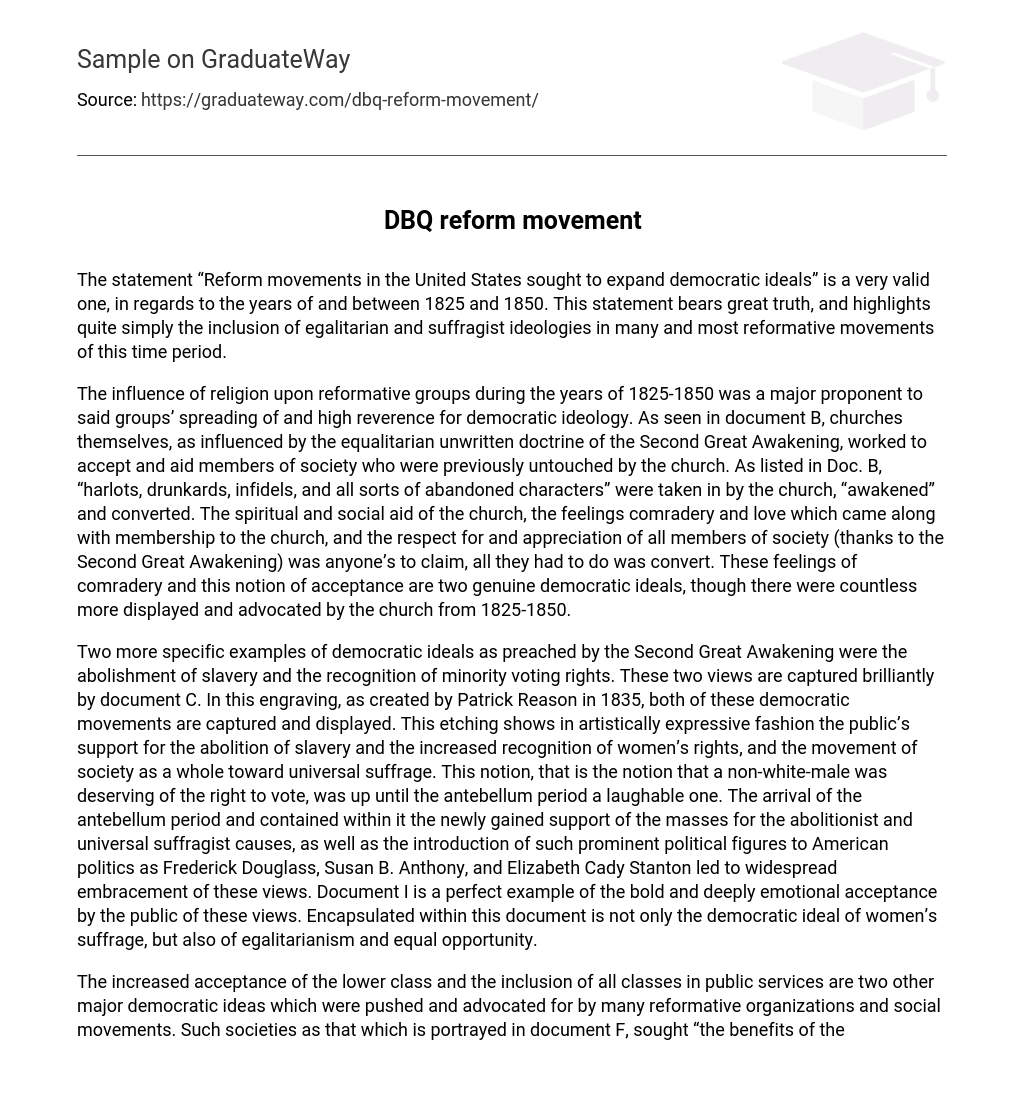During the years 1825 to 1850, a valid statement can be made that reform movements in the United States aimed to extend democratic ideals. This assertion is undeniably true and emphasizes the presence of egalitarian and suffragist ideologies in numerous reform movements during this period.
During the years of 1825-1850, religion had a significant impact on reformative groups, leading to the spread of democratic ideology and a deep reverence for it. As demonstrated in document B, churches were guided by the egalitarian unwritten doctrine of the Second Great Awakening, which motivated them to embrace and assist individuals who had previously been excluded from the church. According to Doc. B, the church welcomed and transformed “harlots, drunkards, infidels, and all sorts of abandoned characters”. The church’s spiritual and social support, the sense of camaraderie and love that came with being a member, and the respect and appreciation for all individuals within society (thanks to the Second Great Awakening) were available to anyone who chose to convert. These notions of camaraderie and acceptance represent two genuine democratic values among countless others advocated by the church during the period of 1825-1850.
During the Second Great Awakening, there was a focus on democratic ideals such as ending slavery and giving minority groups the right to vote. Patrick Reason’s engraving in 1835, depicted in Document C, effectively captures both of these democratic movements. This artwork shows society’s progress towards universal suffrage, recognition of women’s rights, and support for the abolition of slavery. The belief that non-white men should have voting rights was previously rejected but gained widespread acceptance during this time period. Prominent political figures like Frederick Douglass, Susan B. Anthony, and Elizabeth Cady Stanton played important roles in advocating for abolitionism and universal suffrage in American politics. Document I further illustrates public support for these views by demonstrating enthusiasm for women’s suffrage as well as equality and equal opportunities.
Many reformative organizations and social movements advocated for the acceptance of the lower class and the inclusion of all classes in public services, two major democratic ideas. Document F portrays a society that sought equal access to education for all members, emphasizing physical, intellectual, and moral education. Although public education was not universally free or mandatory between 1825 and 1850, reformative groups and society itself started advocating for it. The burden of private payment for school is evident in document E, which depicts the life of an indigent child whose parents struggle to afford his education. Despite this hardship, the boy remains hopeful and happy, traits characteristic of a democratic society that values participation, equal opportunity, and diligence. Activists like Horace Mann played a crucial role in improving educational conditions, advocating for free schooling of higher quality, inclusive of diverse populations and without religious influence. Today, the significance of public education for all as a democratic ideal is often overlooked.
Between 1825 and 1850, there was a surge of reformative movements that aimed at achieving democratic ideals. This period witnessed significant religious and social change, along with increased political activism, which laid the foundation for these movements to flourish. Various reformative groups valiantly fought for democratic ideals such as voting rights for women and African Americans, the abolition of slavery, equality/equal opportunity, and public education. Eventually, American society as a whole embraced these ideals. The forcefulness of the arguments presented by these reformative movements and the unwavering determination of their supporters played a crucial role in embedding democratic ideals into American society, ideals that are often overlooked and undervalued in the contemporary United States.





